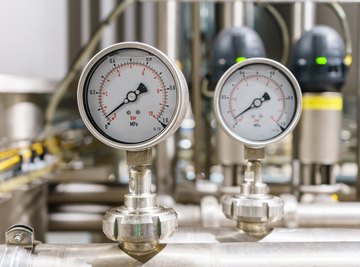
Pressure and force are two different quantities, but they are related because pressure is the force exerted per unit area. In fact, by definition, 1 Pascal is equal to 1 Newton/meter2, which means that 1 megaPascal (MPa) equals 1,000 kiloNewtons (kN)/m2. If you know the pressure exerted on a barrier of known area in MPa, multiply by the area in square meters, and then multiply by 1,000 to get the total force exerted on the barrier in kN.
SI Units of Pressure and Force
One pascal is the SI (metric) unit of pressure. It equals 0.000145 pounds per square inch. The prefix "mega" in the SI system means to multiply the units by a million (106), so a megaPascal is 106 Pascals. Because the Pascal is such a small unit of pressure, it's more common to measure in megaPascals when analyzing hydraulic and other high-pressure systems.
The Newton is the SI unit of force. One Newton equals 0.225 pounds. The prefix "kilo" means to multiply by 1,000, so one kiloNewton (kN) is 1,000 Newtons. When converting from pressure to total force, it's more convenient to measure force in kiloNewtons.
Scientists define the Pascal in terms of Newtons per square meter. By definition, 1 Pa = 1 N/m2. From this, it's easy to derive the relationship between megaPascals and kiloNewtons/meter2:
1 MPa = 106 N/m2 = 106/103 kN/m2 = 1,000 kN/m2
Convert Pressure to Total Force by Multiplying by the Area
Pressure (P) is defined as force (F) per unit area (A). If you know the pressure exerted on a given area, such as the walls of a hydraulic cylinder of known size, you can calculate the total force by multiplying the pressure by the area over which it is exerted: F = PA
When making measurements on machine parts, engineers commonly measure area in square millimeters rather than square meters. If you follow this convention, you'll need the following conversion factor:
1 MPa = 0.001 kN/mm2
You can also do the operation in reverse. If you know the total force exerted to compress a liquid inside a hydraulic cylinder, you can calculate the pressure on the cylinder walls by dividing the force by the area over which it is exerted: P = F/A. When measuring area in millimeters, use the following conversion factor:
1 kN/mm2 = 1,000 MPa.
References
About the Author
Chris Deziel holds a Bachelor's degree in physics and a Master's degree in Humanities, He has taught science, math and English at the university level, both in his native Canada and in Japan. He began writing online in 2010, offering information in scientific, cultural and practical topics. His writing covers science, math and home improvement and design, as well as religion and the oriental healing arts.
